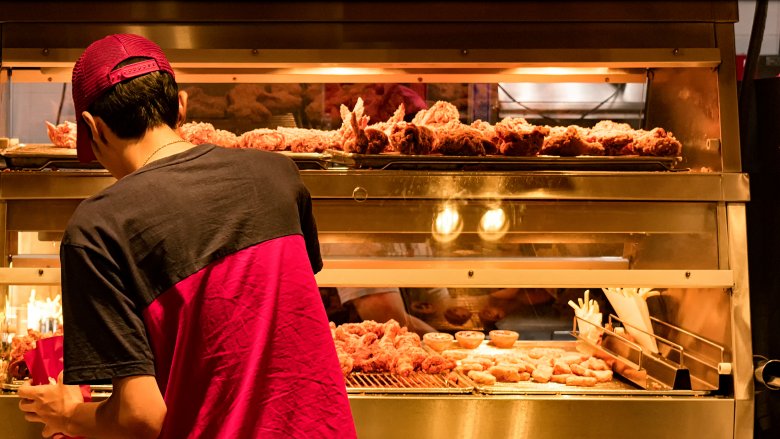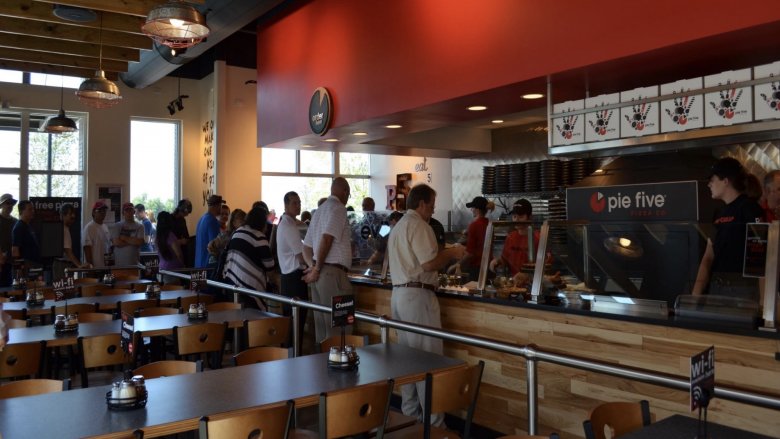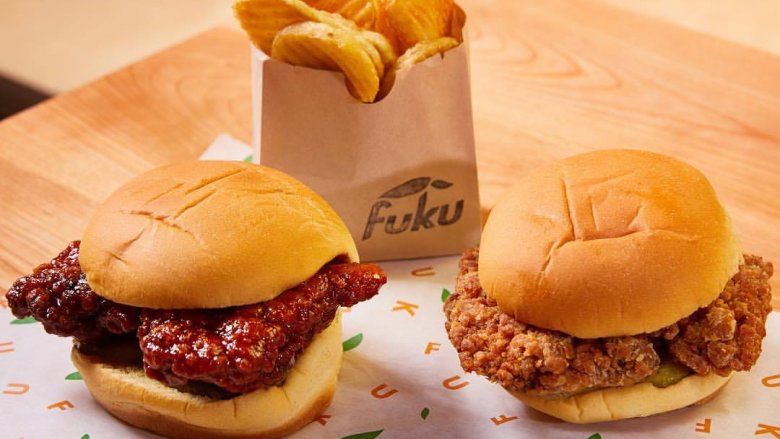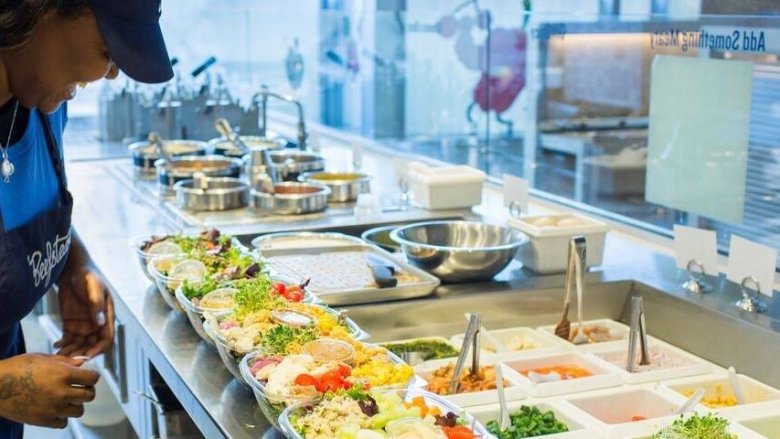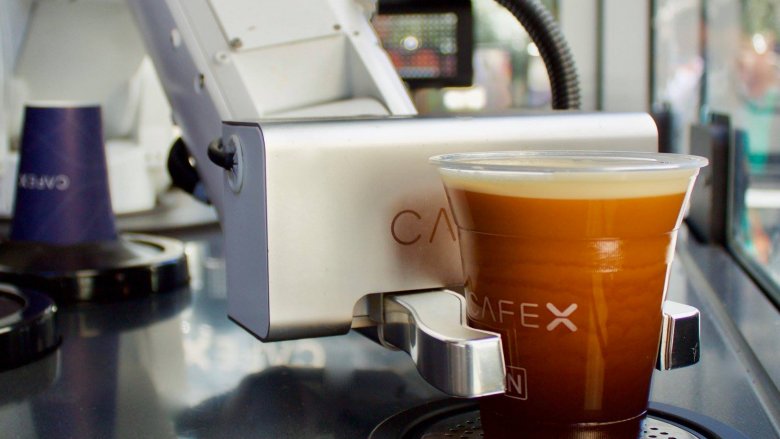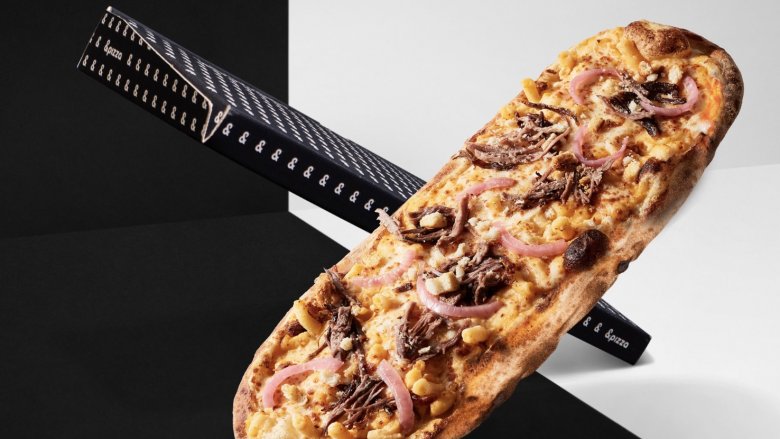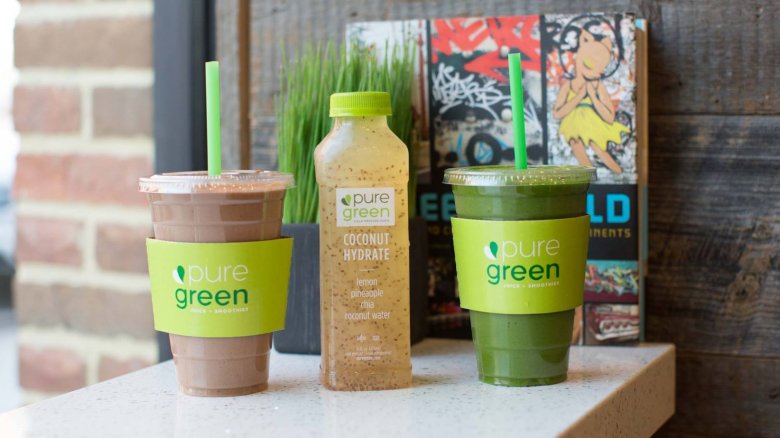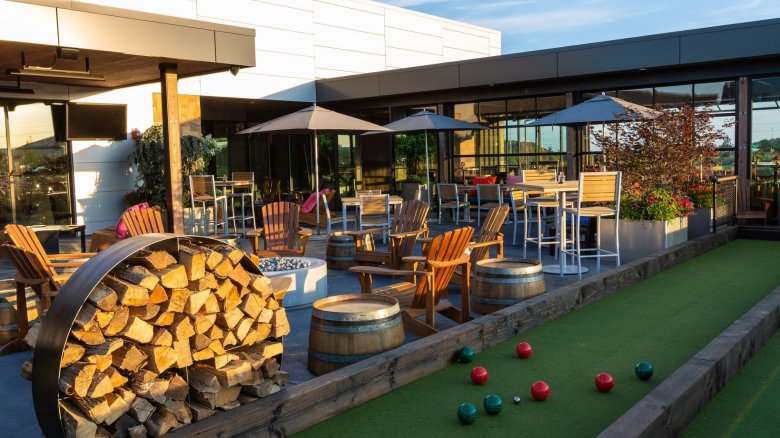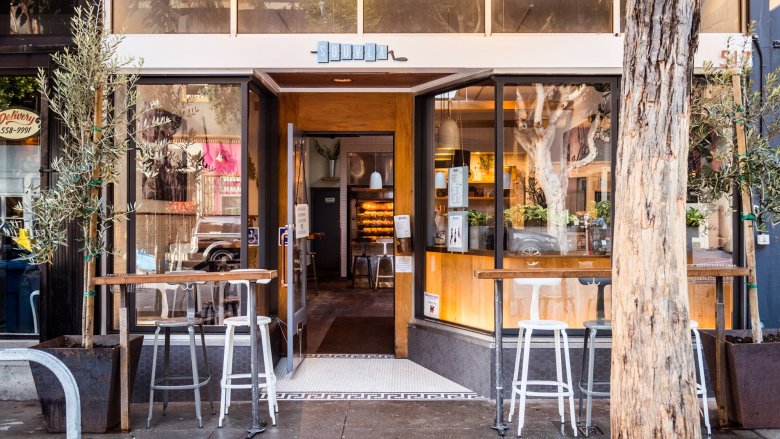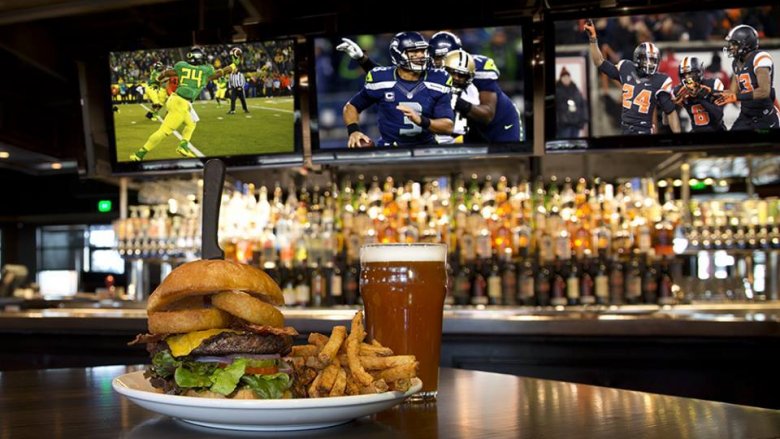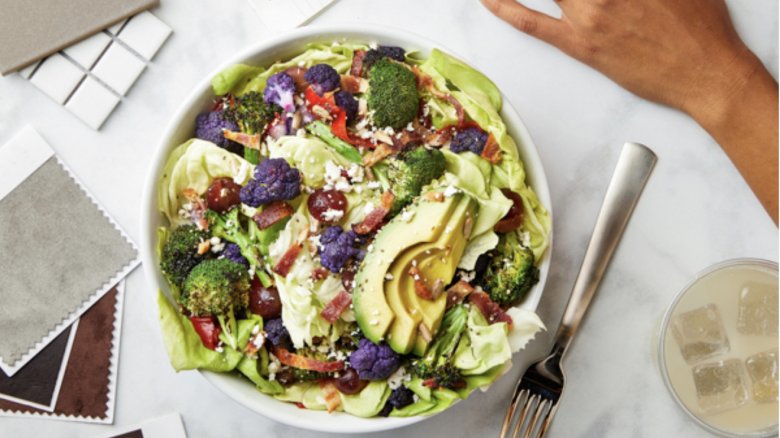New Fast Food Chains That Are Doomed To Fail
Fast food has been a staple of American culture since the '50s. It all began with White Castle in 1921, then continued with McDonald's in the 1940s, and Burger King in 1954. For decades after the popularization of fast food, these industry titans, along with the likes of Taco Bell, KFC, and Wendy's, among countless others, cornered the market for fast, cheap, feel good food. However, in recent years, new fast food chains have emerged to break the mold.
Often rebranding as "fast casual" restaurants, chains like Shake Shack and Sweetgreen have changed the way Americans think about fast food. Some new chains have even attempted to make their food healthier and from fresher ingredients — and sometimes that works.
However, not every new fast food chain has hit the mark. It's hard enough to run a successful restaurant, let alone run a whole chain in a market that seems to become more and more saturated each year. Whether it's because of its silly gimmick or unoriginal concept, here's a list of new fast food chains that are doomed to fail.
Pie Five Pizza
One new chain we don't expect to see around much longer is Pie Five, a pizza chain that claims to use fresher ingredients than their competitors and offers five-minute pizzas with unlimited toppings. The first few years after the 2011 launch of Pie Five Pizza were promising, with its fast and fancy pizzas proving to be a major draw. At one point, the chain had around 100 locations. However, despite its impressive list of units across the southern states, the chain has been in an economic free fall since 2014. In 2017, they had to close 18 stores, and later in 2018, the chain reported that system-wide retail sales declined 18.8 percent in Q2 of 2017 from the year prior.
There are a few possibilities as to why the once promising chain is on the decline. It could be because consumers are choosing local pizzerias over chains, or because the pizza market is already so over-saturated that no one has room for a new pizza spot. Whatever the reason, the chain would certainly be wise to consider some rebranding. Scott Crane, CEO of the parent company, Rave, claims that they will do just that, telling QSR, "We are diligently pursuing a refranchising strategy at Pie Five... this shift in our model allows us to focus on best-in-class support of our franchise community so that they can, in turn, provide a great guest experience."
They may be making changes, like offering healthier crust options and larger, shareable pizzas, but it's not working yet. Sales are still falling, according to numbers released from their parent company in late 2018.
Fuku
From the creator of one of the most over-hyped and over-priced "noodle bars" that New York City has to offer comes an equally over-hyped and over-priced chicken sandwich joint. David Chang, most well-known as the creator of Momofuku Noodle Bar has decided to put his pretentious stamp on one of the most beloved American classics: the fried chicken sandwich. For the most part, Fuku has received good reviews. However, that's likely because two out of its three locations are located in Manhattan, and if there's anything that New Yorkers love more than "noodle bars," it's paying too much for classic American food that was created to be affordable to the lower classes. Besides, Chick-fil-A has already cornered the market on chicken sandwiches. Good luck competing against that giant.
However, if overpriced fried chicken isn't enough to get your pretentious meter beeping, perhaps the fact that neither New York location accepts cash. Despite the fact that cashless restaurants have increased in popularity recently, this means that you have to have enough money to open a bank account or good enough credit to apply for a credit card in order to eat fried chicken at this restaurant. This place is so awfully ironic, it might make you lose your appetite.
Beefsteak
One new chain without a lot of staying power is Beefsteak, a fast casual restaurant that offers bowls of vegetables, either pre-designed or made-to-order. The chain has several aspects that resemble Chipotle, but without the Mexican vibe. If you're trying to create a restaurant chain that has a similar concept to one of the country's most popular chains, you'd probably want to distance yourself from that chain as much as possible. Beefsteak fails at this — it's basically just Chipotle with more vegetables (and no burritos). Remember, Chipotle does do bowls and salads. The interiors even look and feel like a Chipotle, with the light-colored wooden booths and glass counter that displays all the add-on items. The chain's tagline is "Vegetables, unleashed," but no one's ever gone to Chipotle and thought, "darn, I sure wish there were more vegetable options."
And while it's non-Mexican vibe may be all that sets it apart from a well-known superstar, it may also be why it fails. Beefsteak is cuisine-agnostic, meaning it doesn't stick to any one main cuisine. So where does that leave it when you get a craving for any type of food? Not on your list, that's for sure!
Anyone that does really just want a salad will go someplace like Sweetgreen — they have fun, tastier topping options like smoked goat cheese dip and curry roasted cauliflower that trick your brain into not thinking you're not just eating rabbit food.
Café X
If there was ever a perfect example of a restaurant chain taking a tried and true restaurant concept, slapping a silly gimmick on it, and calling it something new, Café X would be it. This fully automated, robot coffee shop originated in none other than the tech capital of the United States, San Francisco. Some people may say that this is the future of restaurants -– that one day, a robot will take your order, make it, and hand it to you. That being said, if you've ever seen the film Ex Machina, you might not think it's such a great idea.
Sure, it's fun and high-tech, but it also completely eliminates the need for employees and the concept of hospitality. A robot is never going to ask you how your day was and actually care about your answer. Once the novelty wears off of the robot experience, coffee aficionados will more than likely miss the smiles (and special coffee tweaks) from their favorite baristas. It won't be long before Cafe X regulars are heading back to Starbucks — you can order from your app there too, after all.
&pizza
The second pizza chain on this list, &pizza, made its first mistake when they came up with a name. Starting the name with an ampersand not only makes it look awkward to grammar enthusiasts (what, no capital letters?), but a good portion of potential costumers aren't sure how to even say the name correctly. You know what that guarantees? That they won't be recommending it to friends no matter what it tastes like. Offense number two: Not only are there too many pizza chains to count, but this one seems to be catering to the millennial hipster scene — a trend that is (thankfully) starting to fade into oblivion.
It also doesn't help that the interiors of the restaurants look (and sound) more like a rave than a pizza place with their startling decor and loud music. They also frequently post photos on their website and social media trying to make pizza look artsy. Pizza is pizza — it doesn't have to be artsy, healthy, or complicated. It just has to taste good. There are over 75,000 pizzerias in the United States. This one might make it in the select cities they've already staked out, but good luck getting farther than that.
Pure Green
Next on the list is Pure Green, a smoothie and juice chain catering to the fit and wealthy. With most of their smoothies costing $8.50 or more, this overpriced chain is proof that the smoothie and juice fad is getting way out of control. While they offer more than just smoothies, including acai bowls and juice cleanse programs, they seem to primarily be known for their smoothies. Several locations are only a few blocks from gyms, CrossFit facilities, and yoga studios, catering to the fitness crowd and promoting a post-workout fruit boost.
Since the chain only currently has locations in New York, it's understandable how the various locations have been able to stay open for so long. The cost of living in New York is one of highest in the United States, so higher prices on food, especially trendy food like juices and smoothies are more commonly expected. However, the chain is likely to either remain restricted to only the most expensive cities or fail completely as the trend dies down and people are less willing to spend as much.
Pinstripes
Perhaps the restaurant with the biggest gimmick on this list, Pinstripes, is a bistro with a bowling alley and bocce courts. Just because Alamo Drafthouse successfully combined a movie theater with a restaurant doesn't mean that any recreational activity can or should be combined with a restaurant. This gimmick makes absolutely no attempt to pretend to be anything but. The bistro section of the restaurant wouldn't have any need for the bowling and bocce courts if the food was up to par.
After going to this restaurant as a last-minute birthday party idea, customers will likely realize that the combination of the two just doesn't work. After the first visit, the gimmick charm will wear off and most consumers will realize that it makes more sense to just go to a decent restaurant and then a to a bowling alley or bocce court afterwards. You can't enjoy a good meal while trying to play a game in between bites — or while a rowdy crowd celebrates a winning game right beside you.
Souvla
The next doomed restaurant in Souvla, a Greek restaurant that defines itself as a "fast-fine" restaurant. That's really all you need to know. All "fast-fine" means is that someone decided they were too good for fast food but didn't want to spend the money on hiring the full staff required for a fine dining establishment. Not only does this concept completely negate the whole purpose of fast food, but also insults it. Fast food is supposed to be fast, feel-good, and simple. As a fast food chain, you should be comforting your customers, not making them feel confused and under-dressed because you couldn't pick a cohesive concept.
Considering Souvla is a Greek chain, you'd think they'd be more open to casual dining. Greek culture is riddled with street food and casual, comfortable meals. This is by far the most confused chain on this list, and it's only a matter of time before the consumers realize what a joke "fast-fine" is.
Thirsty Lion
Then there's Thirsty Lion, a "gastropub" with with locations in the southwest and pacific northwest. This chain may not technically be fast food, but it represents a larger restaurant trend that needs to be put to bed: the gastropub. The only difference between a gastropub and a restaurant is that a gastropub has a higher focus on the food and ingredients. When they started in England the name had real meaning, but as often happens, Americans have stripped it of its novelty. Here, the term "gastropub" has become just a fancy way of saying that you think you're too good just to be an average pub, and Thirsty Lion is no exception. The menu looks like any other pub menu, offering fries, burgers, and beer. Their website makes no claim to locally-sourced ingredients or regularly chaning enues,
Thirsty Lion, along with the rest of the gastropub trend, will likely die out when consumers realize that there's no real difference between a gastropub and any other restaurant. The term is just a curtain that unoriginal chains use to convince the public that they're special and trendier than they really are.
Mixt
The last on this list is Mixt, a build-your-own salad chain that brings nothing new to the formula. Both the website and interiors look like they copy and pasted from Sweetgreen or Chopt. When there are two incredibly successful chains that have already cornered a market, a new chain will really have to step up its game to gain any traction and stand out. Unfortunately, Mixt just ends up looking like a copycat.
Consumers are much more likely to go to Sweetgreen or Chopt because they're already familiar with the concept and menu. Even if someone were to give Mixt a chance, they will realize that it's essentially the same as the other two giants and be indifferent about which on they prefer. Especially since the build-your-own salad concept is already a niche on its own, Mixt will definitely fall by the wayside if it can't find a way to stand out.
